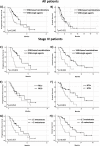Vinorelbine in Non-Small Cell Lung Cancer: Real-World Data From a Single-Institution Experience
- PMID: 31806078
- PMCID: PMC7851511
- DOI: 10.3727/096504019X15755437099308
Vinorelbine in Non-Small Cell Lung Cancer: Real-World Data From a Single-Institution Experience
Abstract
The use of vinorelbine as a single agent or in combination regimens in non-small cell lung cancer (NSCLC) is associated with satisfactory clinical activity. However, the role of vinorelbine-based chemotherapy in chemonaive locally advanced unresectable or metastatic NSCLC patients, according to real-world treatment patterns, has still not been widely explored. Eighty-one patients treated at a single institution were retrospectively analyzed. Thirty-seven received standard first-line single-agent vinorelbine, and 44 received vinorelbine plus platinum drugs, based on physician's choice; 61.7% were older than 70 years, and 60.5% were affected by ≥2 comorbidities. Sixty-three patients were evaluable for objective response: 22% achieved partial response and 41% stable disease. Median progression-free survival (PFS) was 5.4 months. A benefit in PFS was observed in patients treated with combinations vs. single-agent vinorelbine (6.7 vs. 3.5 months, p = 0.043). Median overall survival (OS) was 10.4 months without a statistically significant difference between treatments (12.4 vs. 7.5 months). In 55 stage IV patients, OS was positively correlated with combination regimens, M1a stage, or ≤2 metastatic lesions. Grade 3-4 toxicity occurred in 33% of patients, and dose reduction in 11%. A statistically significant higher incidence of toxicity was observed in patients receiving combinations, in women, in patients younger than 75 years, or patients with metastases. In this real-word analysis, we confirmed the efficacy and tolerability of vinorelbine as a single agent or combined with platinums in patients usually underrepresented in controlled clinical trials. Single-agent vinorelbine may represent a suitable option in elderly or unfit NSCLC patients and warrants investigation as a potential drug candidate for immunochemotherapy combination regimens.
Conflict of interest statement
The authors declare no conflicts of interest.
Figures

References
-
- Siegel RL, Miller KD, Jemal A. Cancer statistics, 2020. CA Cancer J Clin. 2020;70:7–30. - PubMed
-
- Baggstrom MQ, Stinchcombe TE, Fried DB, Poole C, Hensing TA, Socinski MA. Third-generation chemotherapy agents in the treatment of advanced non-small cell lung cancer: A meta-analysis. J Thorac Oncol. 2007;2(9):845–53. - PubMed
-
- Grossi F, Aita M, Defferrari C, Defferrari C, Rosetti F, Brianti A, Fasola G, Vinante O, Pronzato P, Pappagallo G. Impact of third-generation drugs on the activity of first-line chemotherapy in advanced non-small cell lung cancer: A meta-analytical approach. Oncologist 2009;14(5):497–510. - PubMed
-
- Scagliotti GV, Parikh P, von Pawel J. Biesma B, Vansteenkiste J, Manegold C, Serwatowski P, Gatzemeier U, Digumarti R, Zukin M, Lee JS, Mellemgaard A, Park K, Patil S, Rolski J, Goksel T, de Marinis F, Simms L, Sugarman KP, Gandara D. Phase III study comparing cisplatin plus gemcitabine with cisplatin plus pemetrexed in chemotherapy-naive patients with advanced-stage non-small-cell lung cancer. J Clin Oncol. 2008;26(21):3543–51. - PubMed
-
- Johnson IS, Armstrong JG, Gorman M, Burnett JP Jr. The vinca alkaloids: A new class of oncolytic agents. Cancer Res. 1963;23:1390–427. - PubMed
MeSH terms
Substances
LinkOut - more resources
Full Text Sources
Medical
